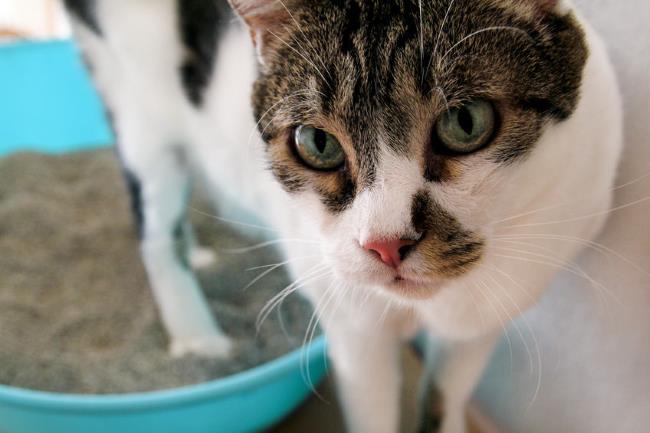
Is your cat not using the litter box? Cats stop using their litter boxes for a variety of reasons, including issues with the box or litter, dissatisfaction with the placement or number of boxes, changes in the environment inside or outside the house, and undiagnosed medical conditions. You may have to investigate several possibilities before you understand what your cat is trying to tell you, but most issues are easy to remedy.
Try to keep in mind that cats don’t eliminate outside their litter box to purposefully annoy you. Punishment won’t stop or correct the behavior. Since most cases of litter box avoidance are stress-related, punishment only increases the stress (for you and your kitty) and makes it harder to identify the real cause.
Ruling out cat health problems
The first step is to take your kitty to your vet for a thorough physical exam. Several medical conditions may result in a cat not using the litter box, so you’ll want to rule these out before looking at other potential causes. The good news is that most medical conditions that cause lapses in litter box use can be easily and inexpensively remedied. Some signs that your cat might need an urgent vet visit are straining to urinate, licking his/her genital area excessively and blood in the urine.
Here’s the next thing to consider: Are all your cats spayed or neutered? Kitties who aren’t neutered may be more likely to urinate inappropriately. You can check SPAY USA’s website to see if there’s a clinic or veterinarian in your area that offers low-cost spay/neuter services.
About declawed cats and litter
It is not unusual to see litter box and other behavior issues in cats whose front claws have been removed. Cats deprived of their front claws may develop an aversion to the litter box because their paws remain sensitive or painful from the surgery, so they avoid scratching in their litter and may begin eliminating around the house instead. Look for products such as aspen or pine wood shavings (commonly used for guinea pigs or mice) or soft paper litter such as Yesterday’s News. Shredded paper is another option for you to try.
Why cats don’t use the litter box
Once you’ve ruled out possible medical conditions as the cause, turn your attention to the litter box itself, since this is most often the culprit. Here are some common reasons why a cat might avoid the litter box:
▪ There aren’t enough litter boxes
▪ He doesn’t like the type of litter
▪ He doesn’t like the type of litter box
▪ He doesn’t like where the box is located
▪ The litter box isn’t clean
Number of litter boxes: There should be one litter box for each cat in the house, plus one extra (more if you have many cats). Some cats prefer to urinate in one box and defecate in another, so sometimes adding more than one box per cat helps.
Litter preferences: If you’ve changed brands or types of litter recently, that may be the problem. Many cats have specific preferences about litter. Cats have sensitive noses and are not fond of chemical or perfume scents. Studies have shown that the most appealing type of litter to most cats is unscented clumping litter that’s the consistency of fine sand. It’s best to purchase different types, though, and offer them side by side to let your cat choose; try clay litters, shredded paper, sawdust, wood pellets, even sand or dirt. If you need to change to another type of litter, do it gradually by adding a little more of the new product each time you change the litter, until your kitty is used to the new litter.
Litter box preferences: Most commercial litter boxes are too small to comfortably accommodate adult cats, so try a large plastic storage box (such as the ones designed to fit under a bed) and see if a little more room might make a difference. In addition, some cats, especially senior or overweight cats, have difficulty getting into litter boxes with high walls. Covered litter boxes may feel too confining to a stressed cat, so unless your kitty is really shy, try removing the covers. Also, plastic liners are convenient for us, but some cats don’t like them.
Location of litter box: Cats are creatures of habit, so don’t move the litter box suddenly. If you have to move a box from an established location, do it gradually (in extreme cases, just a few inches a day) to give your kitty time to adjust.
Locate the boxes in quiet places that offer a little privacy, away from your cat’s food and water stations. Avoid high traffic zones or noisy areas like laundry rooms. You may have to block off the litter box area with baby gates or pet doors to prevent unwanted intrusions by humans (especially small ones) or other animals.
Avoid placing litter boxes in the corner of a closet or someplace tight, such as between the toilet and bathtub. Your kitty may feel that there’s no escape route from such a vulnerable position. Try placing boxes in several different locations. The cat will use the box in the spot where he or she feels the safest.
Cleanliness: Because cats are very fastidious, you’ll want to keep the litter boxes as clean as possible to encourage their use. Some cats will only use a box once before it has to be cleaned, so it’s important to scoop regularly, particularly in a house with multiple cats.
Scrub out the boxes with mild, low fragrance soap at least once a week, and more often with really popular boxes. Don’t use bleach or ammonia-based products; instead, soak your boxes in diluted vinegar water when necessary to remove the odor.
What to do if your cat prefers to eliminate in inappropriate places
If your cat simply prefers to “go” in other areas of the house, there are things you can do to steer him back to preferring the litter box. To start, set up one or more litter boxes that are very appealing and easy to access. Clean the offended area thoroughly using an enzyme cleaner to help eliminate the odor so your cat isn’t tempted to use the same spot again. Then, block off the area or place something there that serves as a deterrent. Cats usually won’t eliminate where there’s food, so try placing a bowl containing a few favorite treats on the cleaned carpet or floor.
You can also make the inappropriate areas as undesirable as possible by covering them with aluminum foil or plastic wrap. Plastic carpet runners placed “teeth” side up are good for covering large areas. Be sure you cover the area generously. If the spot is a foot or two wide, cover it with something at least four to six feet wide. After a few weeks of success, start removing the covering in areas that the cat is not bothering, working slowly toward the trouble spots.
Another option to consider: Install an outdoor cattery, a place where your cat may prefer to eliminate. Catteries come in all sizes and shapes; you’re limited only by your imagination. They can be large open enclosures with shelves and cubbies where cats can relax and play (and you can relax and play with them), small covered enclosures just big enough for a litter box, or something in between. Make sure that you still take litter box preferences, location and cleaning into consideration.
Finally, in some cases it may be worth talking to your veterinarian about using some neutraceuticals and/or behavior-modifying medications. These meds can be helpful tools while trying to train your cat to urinate in an appropriate place and can help reduce the stress your cat feels.
Resources on feline behavior
Cat behavior can be quite complex. If you’d like to know more, the following books can be very helpful:
▪ Starting from Scratch: How to Correct Behavior Problems in Your Adult Cat by Pam Johnson-Bennett
▪ Your Outta Control Cat by Christine Church
If you’ve tried everything and are still unable to determine the cause of your cat’s behavior, consider consulting a cat behaviorist.


Leave a Reply